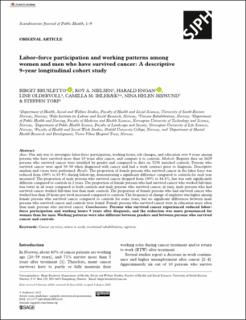Labor-force participation and working patterns among women and men who have survived cancer: A descriptive 9-year longitudinal cohort study
Brusletto, Birgit; Nielsen, Roy A; Engan, Harald; Oldervoll, Line Merethe; Ihlebæk, Camilla; Mjøsund, Nina Helen; Torp, Steffen
Peer reviewed, Journal article
Published version
Permanent lenke
https://hdl.handle.net/11250/2830332Utgivelsesdato
2020Metadata
Vis full innførselSamlinger
Sammendrag
Aims: Our aim was to investigate labor-force participation, working hours, job changes, and education over 9 years among persons who have survived more than 10 years after cancer, and compare it to controls. Methods: Register data on 2629 persons who survived cancer were stratified by gender and compared to data on 5258 matched controls. persons who survived cancer were aged 30–50 when diagnosed with cancer and had a work contract prior to diagnosis. Descriptive analysis and t-tests were performed. Results: The proportion of female persons who survived cancer in the labor force was reduced from 100% to 83.9% during follow-up, demonstrating a significant difference compared to controls for each year measured. The proportion of male persons who survived cancer dropped from 100% to 84.8%, but was only significantly different compared to controls in 2 years. The proportion of female persons who had survived cancer who worked full-time was lower in all years compared to both controls and male persons who survived cancer; in turn, male persons who had survived cancer worked full-time less than male controls. The proportion of female persons who had survived cancer who worked less than 20 hours per week increased compared to controls. The frequency of change of employer was higher among female persons who survived cancer compared to controls for some years, but no significant differences between male persons who survived cancer and controls were found. female persons who survived cancer were in education more often than male persons who survived cancer. Conclusions:Persons who survived cancer experienced reduced labor-force participation and working hours 9 years after diagnosis, and the reduction was more pronounced for women than for men. Working patterns were also different between genders and between persons who survived cancer and controls
